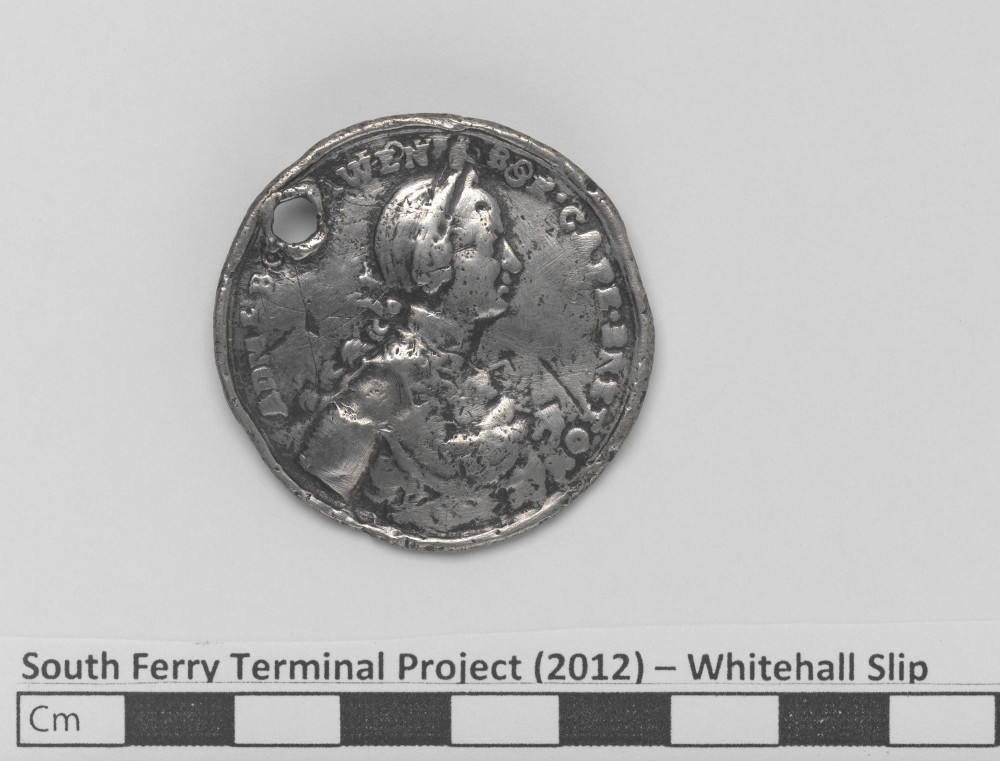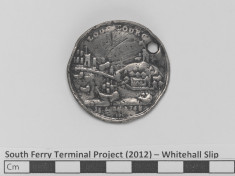Commemorative medal, "ADML. BOSCAWEN . TOOK . CAPE BRE[I?]ON" w/ bust on obverse, on reverse "LOUISBOURG" / IUL 26 1758" w/ view of battle. www.nmm.ac.uk/collections/explore/object.cfm?ID=MEC 1439, hole punched through. G.McGowan conserved "This white metal (pewter) disc was made to commemorate the July 1758 British capture of the Fortress of Louisbourg after prolonged bombardment and a siege of over a month. Louisbourg, on Cape Breton Island, Nova Scotia, was established as a French colonial settlement in 1713. In 1745, troops from New England captured the Fortress but it was returned to France by treaty in 1748. Another British assault in 1758, under the direction of General Jeffrey Amherst and Admiral Edward Boscawen, recaptured the Fortress, the military center of the French in Atlantic Canada and guard the entrance to the St. Lawrence River. After capturing the Fortress, the British blew it up in order to prevent it ever again falling into French hands by treaty or by capture. Taking Louisbourg enabled British ships and troops to advance on Quebec City the following year, effectively ending France’s role in Canada. This token celebrates Admiral Boscawen’s part in the British victory. On the obverse is “ADML. BOSCAWEN .TOOK . CAPE BRETON” with a portrait of the admiral; on the reverse is "LOUISBOURG"/IUL 26 1758" with a view of the battle. The token has been roughly pierced for suspension, possibly as a necklace or as a decoration for a watch chain. Part of it has been double struck, i.e., a mistake was made and the token was struck twice with the die. This can be seen by looking closely at the word “took”: the “T” is obscured and one “O” is intertwined with another. The design on the Whitehall Slip medal is identical to one illustrated in the American Historical Record and Repertory of Notes and Queries for 1872 (Lossing 1872:77) where it is identified as a gold medal presented to Admiral Boscawen by King George in honor of Boscawen’s role in the victory. A copy of this medal, made in brass, is in the collections of the British National Maritime Museum (called there a counter) (http://www.nmmprints.com/image.php?id=393055). An online newsletter of the Medal Collectors of America states the victory at Louisbourg was such a popular event in England that large quantities of cheap brass copies of the King’s Boscawen medal were reproduced for the general public (Medal Collectors Advisory of America 2005). Another source (Betts et al. 1894) adds that reproductions were also made in pewter, an inexpensive alloy of tin and other metals that imitates silver as brass does gold. The Whitehall Slip medal, however, is made of material that archaeologists describe as “white metal,” a term used for combinations of lead and/or tin with other metals in varying proportions; white metal contains proportionately less tin than pewter and is thus even cheaper. The Whitehall Slip medal might have been purchased by a member of the general public or might have been the possession of a sailor or soldier who fought at the battle. A small number of American rangers and artificers fought alongside British regular troops during the battle but it is impossible to tell if an American or a Briton owned this token. Piercing the token probably signified its owner valued it enough to wear it as a personal adornment or as a sign of his own involvement in this famous victory, even though the object itself would not have had much monetary value, given its base metal composition (and perhaps the inaccuracy of its manufacture)." page 6-49--6-50, South Ferry Terminal Project Report, 2012.
-
Object number
1
-
Date made
1758
-
Decoration
-
Category
-
Class
Metal
-
Material
-
Context
-
Techniques
Cast







